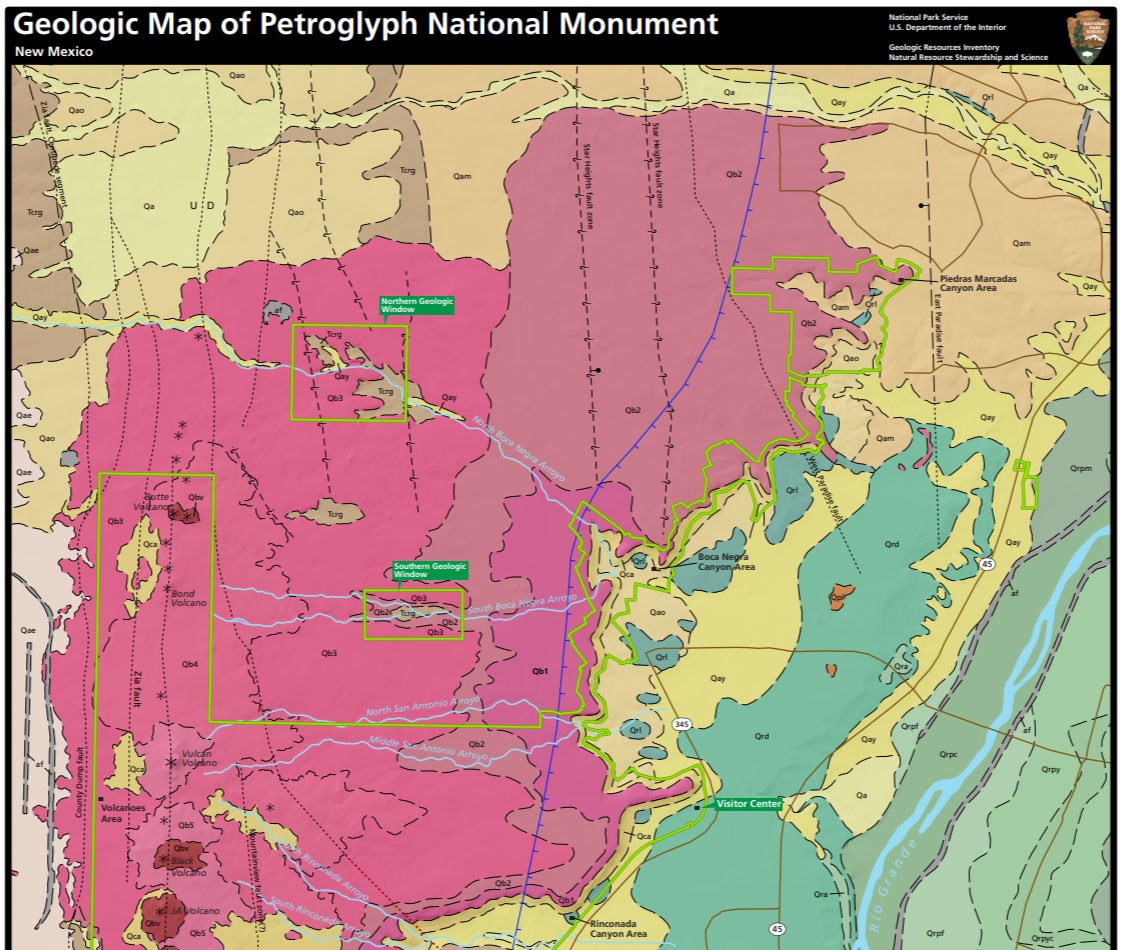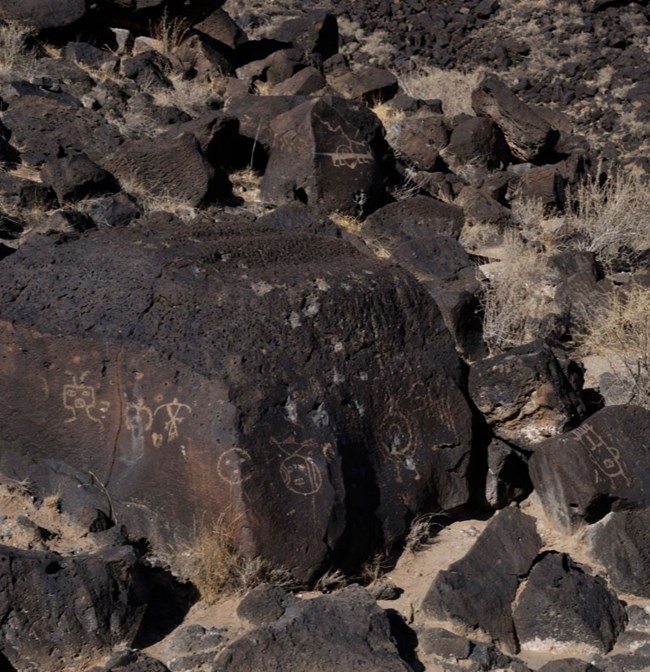Last updated: July 15, 2024
Article
NPS Geodiversity Atlas—Petroglyph National Monument, New Mexico
Geodiversity refers to the full variety of natural geologic (rocks, minerals, sediments, fossils, landforms, and physical processes) and soil resources and processes that occur in the park. A product of the Geologic Resources Inventory, the NPS Geodiversity Atlas delivers information in support of education, Geoconservation, and integrated management of living (biotic) and non-living (abiotic) components of the ecosystem.
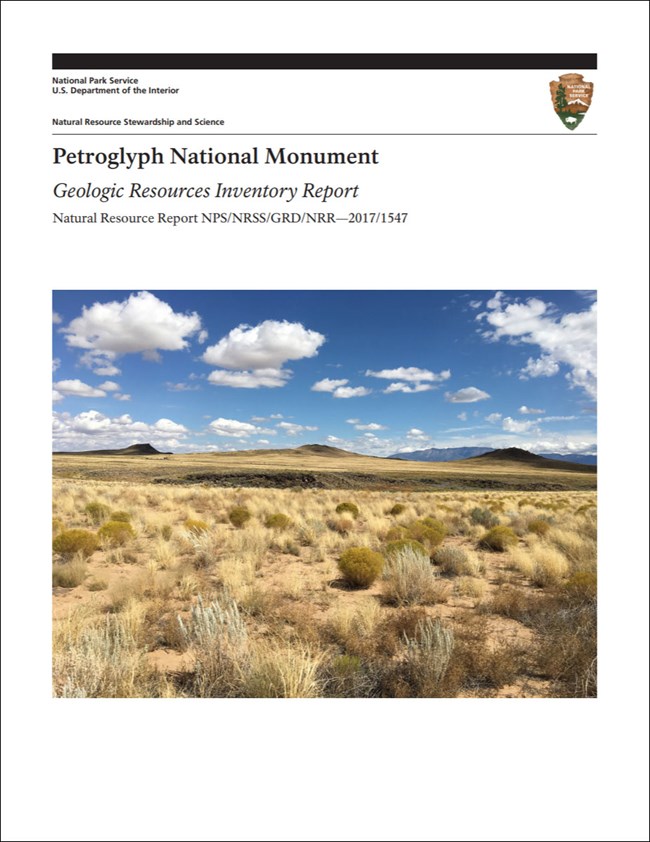
Introduction
Petroglyph National Monument was established to preserve and promote understanding of the more than 24,000 petroglyphs found along Albuquerque’s West Mesa and on other rock outcroppings and boulders in the monument, and the area’s natural and cultural resources. Petroglyphs are rock carvings incised into rock surfaces, typically through a dark coating of desert varnish into the lighter-colored rock below.
West Mesa is an erosional scarp along the margin of lava flows erupted from the Albuquerque Volcanoes. The Albuquerque Volcanoes are a series of low spatter and cinder cones aligned along eruptive fissure located near the center of the Rio Grande rift. The eruptions that formed the Albuquerque Volcanic Field occurred approximately 156,000 thousand years ago.
Petroglyph National Monument’s unique significance is the result of the combination of its geologic and volcanic landscape and rich cultural heritage going back thousands of years.
Geologic Significance & Geodiversity Highlights
Petroglyph National Monument preserves one of the largest petroglyph sites in North America. Most of the petroglyphs were made by the ancestors of the modern Pueblo peoples living in and along the Rio Grande rift, but the oldest rock carvings may be thousands of years old, and the youngest reach into the historic period. The petroglyphs and their surrounding landscape have great spiritual and cultural meanings for contemporary American Indians and for descendants of the early Spanish settlers.
West Mesa, where most of the petroglyphs in the monument are found, is a classic example of volcanic inverted topography. The lava flows are more resistant to erosion than the sedimentary rocks in the area. As erosion progressed, the lava flows remained at a higher elevation than the surrounding land.
The monument encompasses the Albuquerque Volcanic Field including the approximately 17-long (27-km) West Mesa and the Albuquerque Volcanoes.
The 7,236-acre monument is cooperatively managed by the National Park Service and the City of Albuquerque Open Space Division.
Petroglyph National Monument is one of 33 units of the National Park System containing at least one volcano.
Related Links
Geologic Setting
Albuquerque and Petroglyph National Monument are located in the Rio Grande rift. The Albuquerque Volcanic Field is one of several Pleistocene monogenetic fields in the Albuquerque basin in the middle portion of the rift where extension-related basaltic volcanism has occurred.
Related Links
Rio Grande Rift
The Rio Grande rift is an active rift that stretches north-south from the San Luis Valley in Colorado through the center of the state of New Mexico to Chihuahua in northern Mexico. Extension of the rift began about 36 million years ago in the south and about 22 million years ago in the north. Faulting began in the middle part of the rift in the vicinity of Petroglyph National Monument approximately 26 million years ago on faults that are largely oriented north-south.
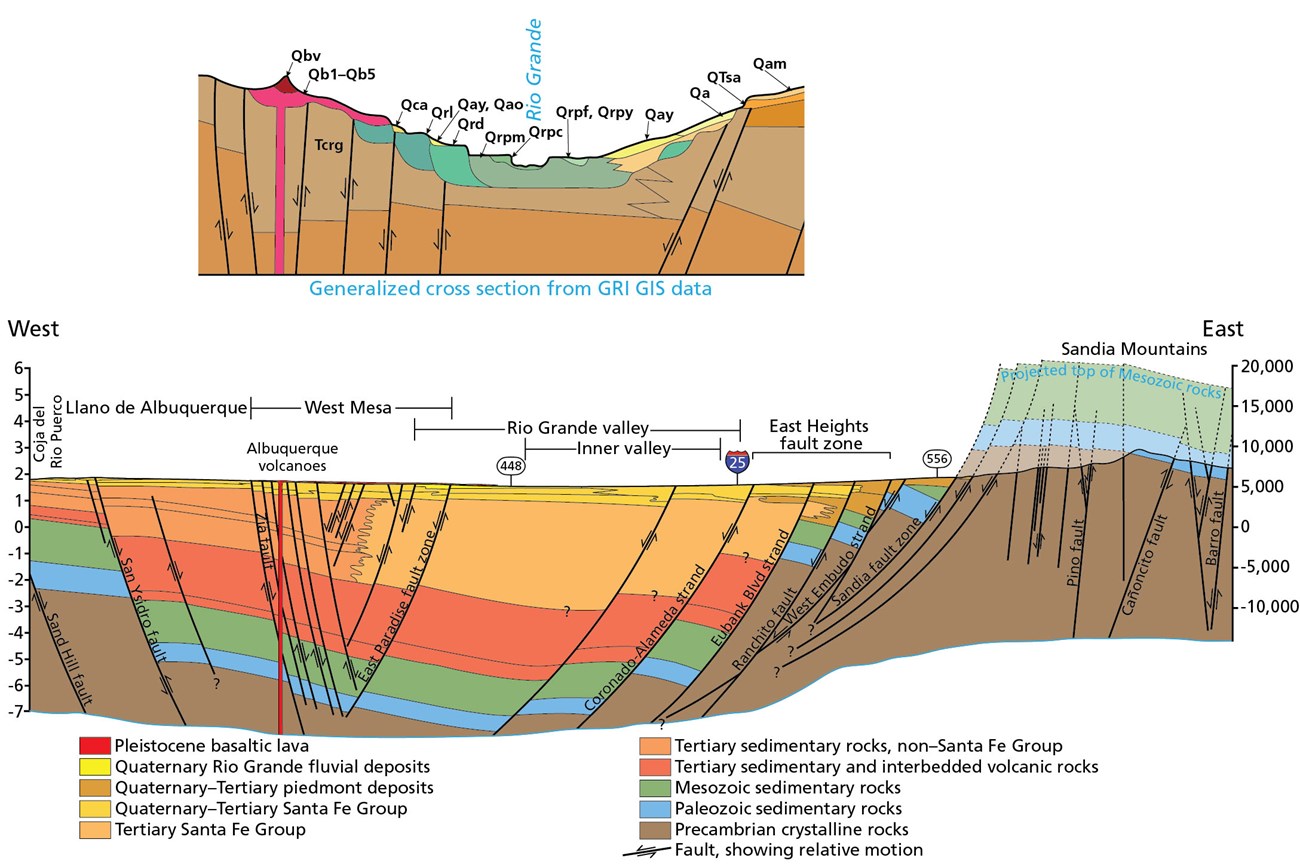
Cross sections of the Albuquerque basin. Normal faults, which are characteristic of the Rio Grande rift, are a prominent feature in the Albuquerque basin. Faulting began at the margins of the rift and moved basinward. A rift-flank uplift—the Sandia Mountains—was elevated as the basin subsided. Today, the Rio Grande dominates the surface of the rift. Since about 1.2 million to 700,000 years ago, the river has episodically incised into the Santa Fe Group (basin-filling sediments), creating terraces (abandoned floodplains) mapped as the Lomatas Negras (Qrl), Los Duranes (Qrd), and Las Padillas (Qrpm) Formations. Tributaries deposited alluvium. Piedmont surfaces (gravel-covered erosional slopes) occur along the flank of the Sandia Mountains but not within the monument. The basaltic lava of the Albuquerque volcanoes (Qb1–Qb5 and Qbv) erupted about 156,000 years ago atop the Llano de Albuquerque; the Ceja Formation (e.g., Tcrg in the monument) marks the top of the Llano de Albuquerque surface and represents the end of basin filling by the Santa Fe Group. Graphic by Trista Thornberry-Ehrlich (Colorado State University) after cross sections by Connell (2006, B–B') and Bauer et al. (2003, p. 6).
Extensional tectonics form down-dropped basins and adjacent uplifted blocks that may form mountain ranges. The Albuquerque basin is one of nine basins identified in the Rio Grande rift. The Sandia Mountains that dominate the viewshed of the monument to the east was formed by a rift-flank uplift. The western margin of the rift is about 12 miles (19 km) west of the monument.
The Rio Grande established its course by integrating rifted basins to establish a through flowing river. The Rio Grande is approximately 2 miles (3 km) east of the monument.
Related Links
Sandia Mountains
The Sandia Mountains are approximately 15 miles (24 km) east of Petroglyph National Monument and rise to 10,447 (3,184 m) in elevation. They were uplifted on the east side of the Rio Grande rift relative to the down-dropped Albuquerque basin. They have exposures of Precambrian igneous and metamorphic rocks and are capped by Pennsylvanian sedimentary rocks.
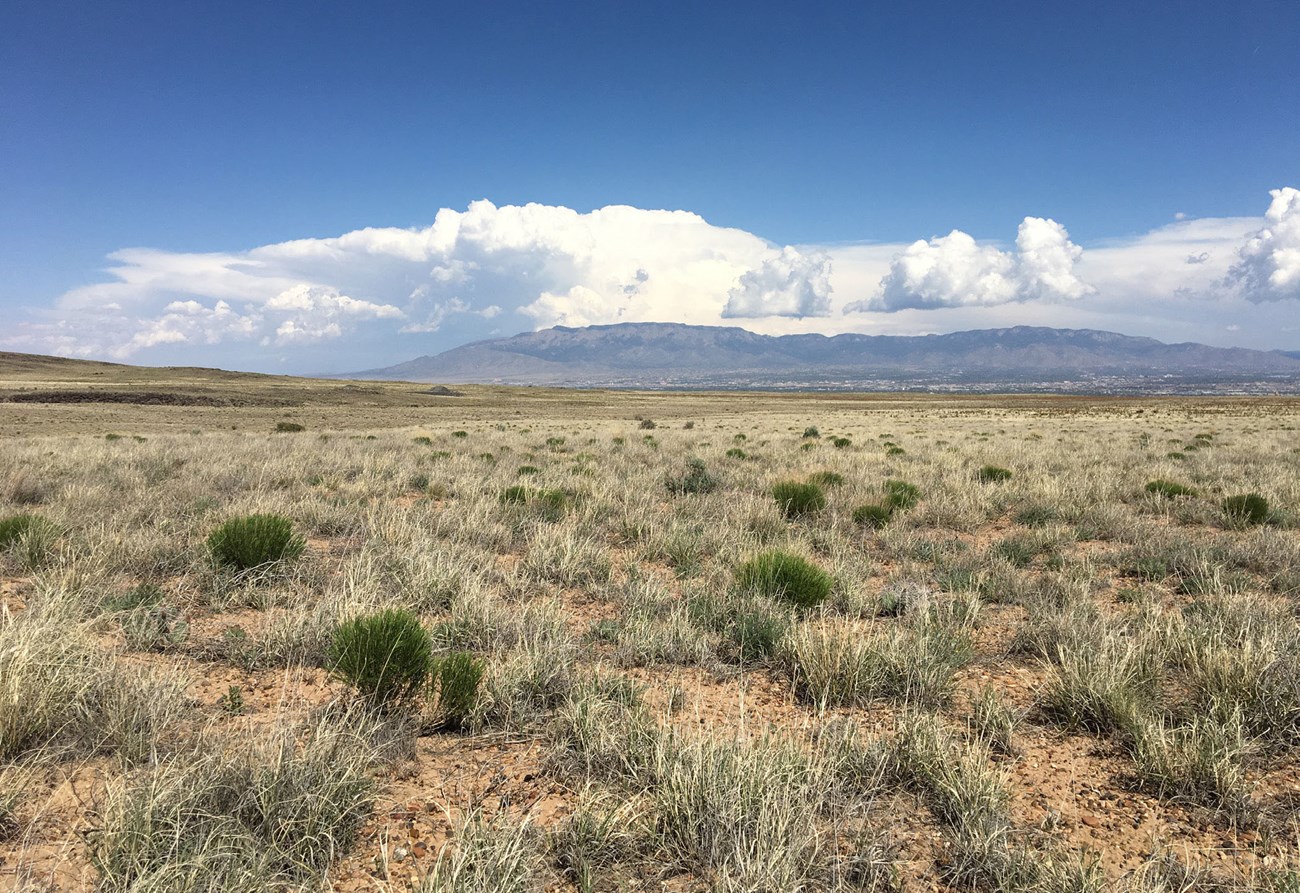
Photograph of the Sandia Mountains. The monument offers spectacular views of the Sandia Mountains. These east-tilted, rift-flank mountains on the eastern margin of the Albuquerque basin rise as much as 1,700 m (5,700 ft) above the elevation of the Rio Grande, exposing Precambrian granitic and metamorphic rocks on the west side of the basin. Pennsylvanian limestone and shale cap the mountain block; these rocks are exposed along the eastern slopes of the mountain range. The Sandia Mountains are not part of the GRI GIS data but are clearly within the monument’s viewshed. NPS photograph courtesy of Chanteil Walter (Petroglyph National Monument).
Monogenetic Volcanic Fields
The Albuquerque Volcanic Field is a good example of a monogenetic volcanic field. Monogenetic volcanic fields are clusters of volcanoes or areas covered by volcanic rocks where most of the volcanic vents each experience one period of activity. Large monogenetic volcanic fields may contain hundreds of individual volcanoes and typically include cinder cones, fissure volcanoes, and other monogenetic volcanoes. Monogenetic volcanic fields usually form in areas of low magma supply.
Rift-related volcanism such as that in Petroglyph National Monument occurs because extension thins the continental crust, allowing high heat flow from the mantle to form basaltic magmas. The Albuquerque Volcanic Field is located near the axis of the Rio Grande rift.
The Albuquerque Volcanic Field is one of several small Piocene to Pleistocene volcanic fields in the central Rio Grande Rift. Nearby fields include Los Lunas, which include the Cat Hills volcanic rocks, and Lucero.
New Mexico includes several other monogenetic volcanic fields including the Raton-Clayton Volcanic Field in northeastern New Mexico that contains Capulin Volcano National Monument, and the Zuni-Bandera Volcanic Field where El Malpais National Monument is located.
Other monogenetic volcanic fields in the lower 48 states include the San Francisco Volcanic Field in northern Arizona where its most recent eruption formed the cinder cone preserved in Sunset Crater Volcano National Monument, and the Snake River Plain that includes the three young lava fields of Craters of the Moon National Monument and Preserve.
Related Links
Geologic History
Rio Grande Rift Sedimentary Basin Fill
The oldest rocks found in Petroglyph National Monument are in the Pleistocene Ceja Formation which is the youngest unit in the Santa Fe Group. This unit consists of sands and gravels deposited as basin fill of the Rio Grande Rift when it was an internally drained basin. It also includes sediments deposited by the ancestral Rio Grande and other rivers. Deposition of this unit ended between about 3.6 million and 2.2 million years ago.
Llano de Albuquerque surface
The Llano de Albuquerque is a broad, low relief surface that marks the top of the Santa Fe Group and is the constructional surface of the infilling of the basin floor formed by rifting, representing a period of landscape stability. The surface is between 360 and 705 feet (110 and 215 m) above the modern Rio Grande floodplain. The age of the Llano de Albuquerque is between 2.5 million and 700,000 years old.
The Llano de Albuquerque is the surface that the lava flows erupted from the Albuquerque basin covered. It marks the end of basin infilling prior to the establishment of the modern Rio Grande.
Rio Grande and Tributary Fluvial Sediments
The Lomatas Negras Formation is the oldest terrace deposits of the Rio Grande and stand approximately 210 to 245 (65 to 75 m) above the present river floodplain. It is less than 640,000 years old since it contains the Lava Creek B volcanic ash erupted from the Yellowstone caldera.
Younger terrace deposits in the vicinity of Petroglyph National Monument include the Los Duranes Formation and the Las Padillas Formation. The base of the Los Padillas Formation was probably formed during the last glacial maximum between 22,000 and 15,000 years ago.
Volcanic Rocks of the Albuquerque Volcanic Field
Petroglyph National Monument contains the near-vent deposits and basaltic lava flows produced from activity in the Albuquerque Volcanic Field. The field contains 15 recognized vents, including five named volcanoes. Twelve of the vents are within the monument boundary. The volcanic field covers about 24 square miles (62 km2).
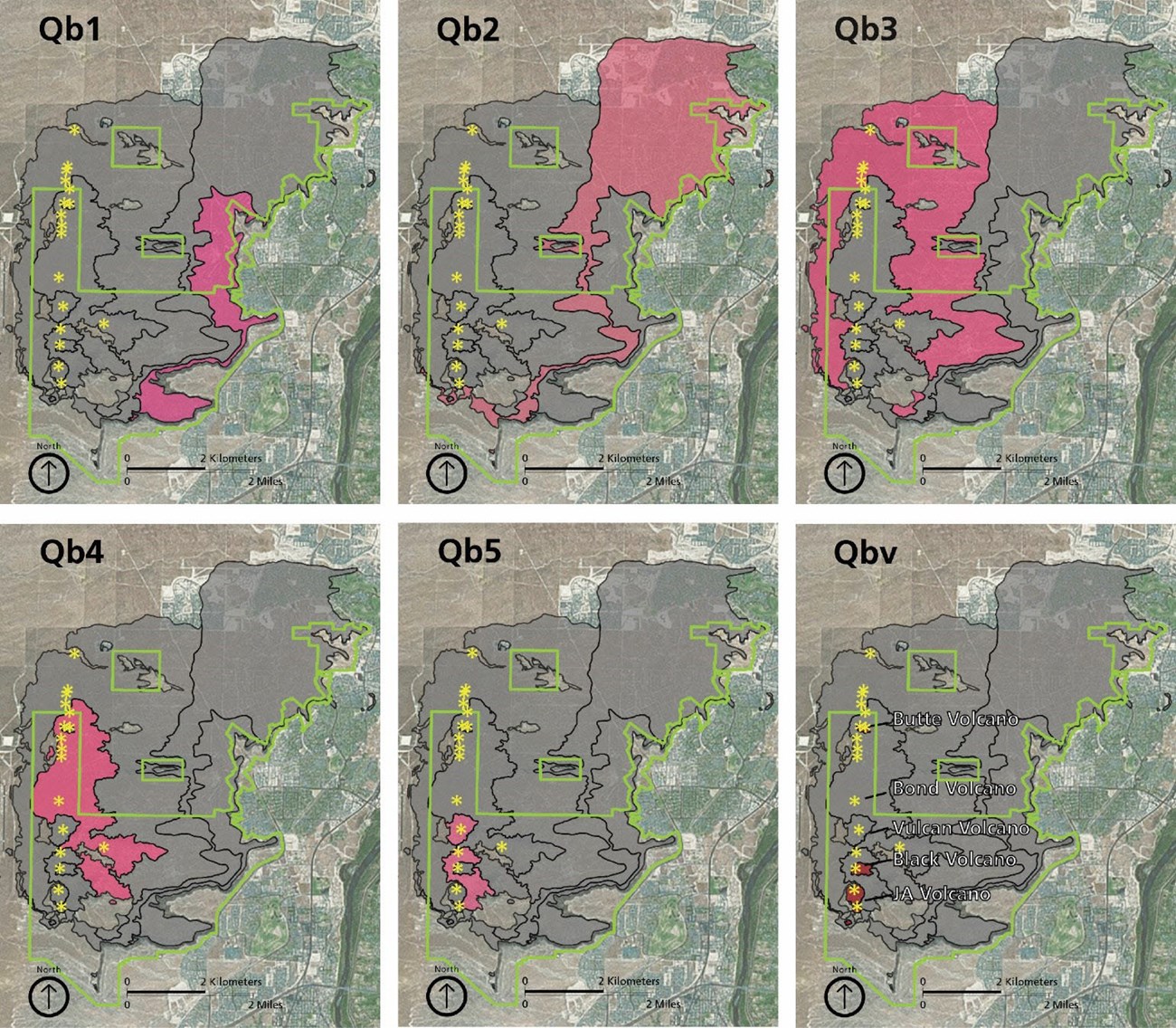
Graphic of the sequence of lava flows and eruptions at the monument and vicinity. Connell (2006) mapped six eruptive phases in the Albuquerque volcanic field. The earliest eruptions (Qb1 and Qb2) were low viscosity and spread to the east from a fissure, which is marked by a vertical line of vents (*) on the figure. Subsequent flows covered earlier flows; lava would have covered the landscape between the vents (line of yellow asterisks) and the edges of flows. During the third eruptive phase (Qb3), lava spread from the fissure to both the east and the west. Later eruptions (Qb4 and Qb5) were thicker and less expansive and became more and more restricted to central vents; they culminated with the formation of cones (Qbv). Graphic by Michael Barthelmes (NPS Geologic Resources Division) using GRI GIS data (petr_geology.mxd) compiled from the source map by Connell (2006).
Five lava flows have been identified in the Albuquerque Volcanic Field based on surface morphology and stratigraphic position. The first two flows traveled greater distances from the vents and make up West Mesa which is near the original eastward extent of these lava flows.
The eruptions that produced the lava flows were effusive to mildly explosive, typically ranging from 0 (Effusive) to 2 (Explosive) on the Volcanic Explosivity Index. Eruption styles were typically Hawaiian where low fire fountains are produced. Strombolian eruptions that are slightly more explosive and look like volcanic fireworks led to the formation of the cinder cones.
Related Links
Geologic Features and Processes
Most of the prominent geologic features in Petroglyph National Monument result from the volcanic eruptions in the Albuquerque Volcanic Field approximately 156,000 years ago. West Mesa, where most of the petroglyphs are located, is an erosional feature capped by resistant lava flows that have eroded away more slowly than the sedimentary deposits in the monument.
Volcanoes
Petroglyph National Monument contains several spatter cones located along an eruptive fissure.
Eruptive Fissure (Fissure Volcano)
Fissure volcanoes (also known as eruptive fissures) are elongated volcanoes that form from eruptions that occur along linear fissures rather than at a central vent. They form when magma-filled dikes intersect the surface. The 4-mile (6.5 km)-long eruptive fissure in Petroglyph National Monument is aligned parallel to faults associated with the Rio Grande Rift.
Fissure volcanoes usually erupt effusively forming extensive lava flows and building small accumulations of spatter, forming low spatter cones. Five named volcanic edifices are aligned along the eruptive fissure in the Albuquerque Volcanic Field. Several other unnamed vents with lesser accumulations of spatter are also located along the eruptive fissure.
From north to south, these volcanoes are Butte, Bond, Vulcan, Black, and JA volcanoes.
Related Links
Spatter Cones
The named volcanoes in Petroglyph National Monument are spatter cones. Spatter cones are low accumulations of spatter. Spatter consists of cinders and globs of lava that were still molten or partially molten when they landed. Because they are still hot, they weld together and may even flow as lava. Spatter cones are frequently formed from fire fountains which are produced in Hawaiian style eruptions such as those that occur at fissure volcanoes.
The spatter cones in the monument share some characteristics with cinder cone volcanoes, but are substantially smaller than, and contain a much higher proportion of spatter compared to most cinder cones. Additionally, some of them also experience deformation caused by injection of magma into them during the latter stages of their eruptions.
Each of these spatter cones consist of a lower slope made of lava flows that were erupted at the vent followed by deposits of cinders and spatter formed during a later, slightly more explosive part of the eruption.
Butte and Bond Volcanoes
Butte and Bond volcanoes are on the north end of the eruptive fissure within the national monument. Each of these volcanoes are only about 50–60 feet (15–18 m) tall, and consist of an upper cone above a lower gentle mound. Butte Volcano has a very shallow crater, and Bond’s crater has been filled in.
Albuquerque Volcanoes
Vulcan, Black, and JA volcanoes are known as the Three Sisters or the Albuquerque Volcanoes.
Vulcan Volcano (also known as J Volcano) is the northernmost of the Three Sisters and is the tallest and most complex volcano in the Albuquerque Volcanic Field. Vulcan Volcano reaches an elevation of 6,033 feet (1,839 m) above sea level and stands approximately 130 feet (40 m) above its base.
Vulcan is a complex volcano, consisting of the main cone as well as satellite vents. The earlier parts of the eruption deposited cinders and ash which were later coated by a mantle of welded spatter. It also experienced deformation near the end of its eruption. It is taller on the south and east sides, indicating that strong winds blew pyroclasts and spatter to those sides during the eruption.
Black Volcano is less steep than Vulcan and has two overlapping summit craters. Its deposits of unwelded cinders have been quarried for use as road and landscaping material.
JA Cone is relatively steep. It experienced late deformation caused by magma ascent and thin lava flows were emitted from radial cracks.
Cinder Cones
None of the volcanoes in Petroglyph National Monument are textbook cinder cones, but they have some characteristics of this volcano type.
Cinder cones are accumulations of volcanic cinders (scoria) and ash accumulated around a central vent. Their steep slopes average approximately 30 degrees, close to the angle of repose for volcanic cinders.
Cinder cone eruptions are usually mildly explosive and at a 1 (Severe) or 2 (Explosive) on the Volcanic Explosivity Index, with a Strombolian eruption style that looks like volcanic fireworks. Their eruptions typically last a short period of time (from months to a few years), and lava flows may be emitted from vents at the base of the cinder cone, particularly during the waning stages of an eruption.
Related Links
Lava Flows
Five lava flows were erupted from vents along the eruptive fissure in the Albuquerque Volcanic Field. The flows are differentiated based on surface morphology and stratigraphic position. (See lava flow sequence image above.)
These lavas traveled mostly to the east because the Llano de Albuquerque, the surface upon which they were erupted, slopes gently to the east. As a result, most of the area covered by lava flows is east of the eruptive fissure.
The two oldest flows traveled the greatest distances from the eruptive fissure, indicating that they were less viscous than later flows or that a greater volume of lava was emitted in the earlier eruptions. They also form the eastern margin of West Mesa.
Lava flow 5 was erupted from Vulcan and Black volcanoes and only covers a small area in the immediate vicinity of these cones.
The flows were thin, and where flow tops are preserved, had pāhoehoe (ropy) morphology. The tops were vesicular and had low relief. Lava flow surface features include tumuli, and lava channels and gullies, and pāhoehoe toes.
Related Links
Volcanic Inverted Topography
West Mesa, which stands about 100 to 180 feet (30 to 55 m) above the valley floor, formed as a result of differential erosion. The lava flows erupted along the eruptive fissure traveled downslope across the Llano de Albuquerque, which was the low part of the Albuquerque landscape at the time of the eruption.
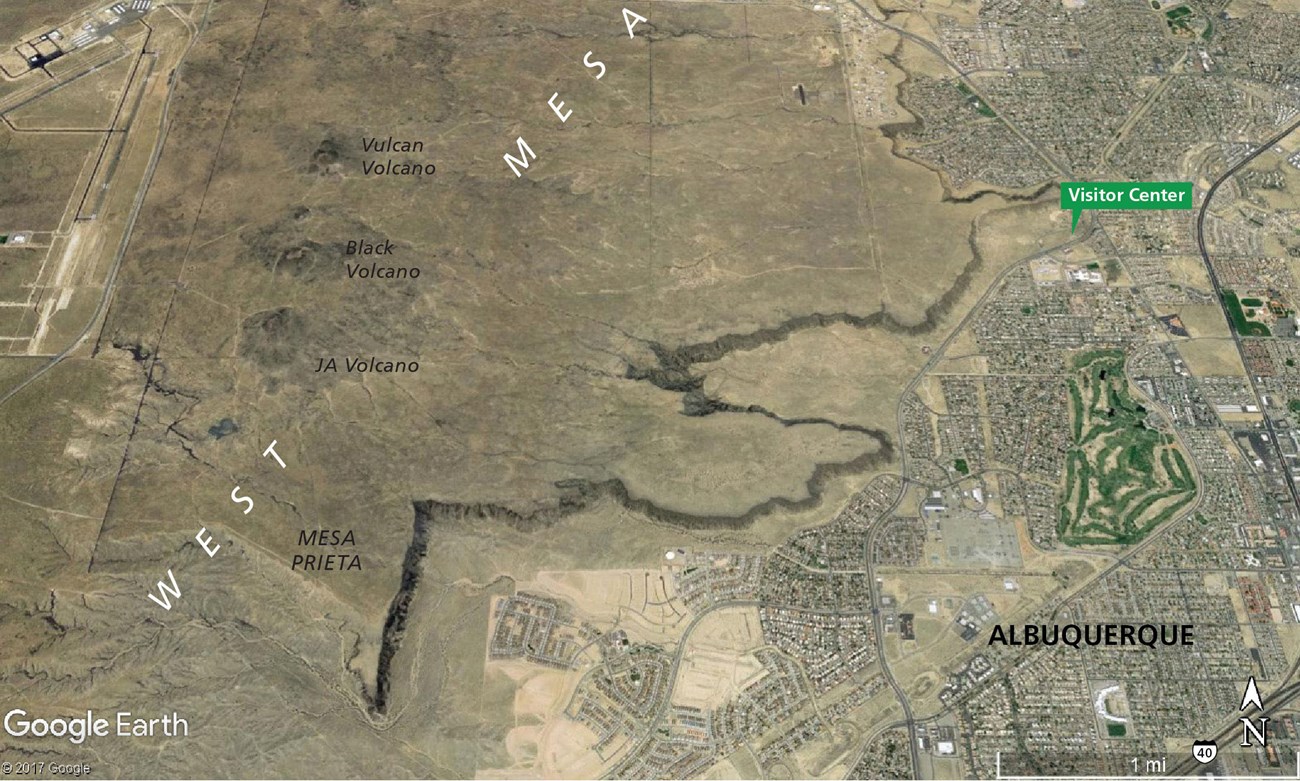
Satellite image of West Mesa. Much of West Mesa—a basaltic lava–capped “table land”—and its 23-km- (17-mi-) long escarpment lie within the monument. Lava flows topped by spatter cones and cinders cover the mesa’s surface. The mesa is west of the Rio Grande and downtown Albuquerque, New Mexico. Image © 2017 Google. Annotations by Jason Kenworthy (NPS Geologic Resources Division).
The volcanic rock in the lava flows is more resistant to erosion than the gravels and other sedimentary deposits in the area, so they have not eroded as rapidly as the softer gravels. As a result, the lava flows stand at a higher elevation than the surrounding land.
While West Mesa is an erosional scarp, the lava flows probably did not travel much further than its current location. There are not erosional remnants of the flows beyond the blocks that have fallen from mesa during mass wasting events. If the eastward extent of the lava flows were much more extensive than the current location of the mesa, it is likely that erosional remnants or blocks of lava flows would be present elsewhere.
Volcanic inverted topography such as West Mesa is found throughout the young monogenetic volcanic fields in the American southwest because of the area’s rapid arid-land erosion.
Related Links
Paleontological Resources
The only fossils that have been documented in Petroglyph National Monument are cobbles made of petrified wood in the Ceja Formation. These pieces of petrified wood were likely eroded out of Triassic units in the vicinity and deposited as part of the sediments that became the Ceja Formation.
All NPS fossil resources are protected under the Paleontological Resources Preservation Act of 2009 (Public Law 111-11, Title VI, Subtitle D; 16 U.S.C. §§ 470aaa - 470aaa-11).
Caves and Karst
Small lava tube caves are present in Petroglyph National Monument. Lava tubes found in lava flows near the vents of the spatter cone volcanoes are small with diameters of about 8–20 inches (20–50 cm) and are discontinuous.
Differential weathering of welded spatter deposits found near eruptive vents has also formed small, cavernous openings.
Volcanic landscapes where lava flows are present are considered a type of pseudokarst. Pseudokarst is formed through geological processes that do not involve dissolution of rock, which occurs in true karst. Lava tubes and collapsed tubes are volcanic pseudokarstic. Based on the presence of volcanic bedrock, 57% of Petroglyph National Monument was identified as containing pseudokarst.
All NPS cave resources are protected under the Federal Cave Resources Protection Act of 1988 (FCRPA)(16 U.S.C. § 4301 et seq.).
Related Links
Other Geodiversity Values
Petroglyph National Monument’s primary purposes are to preserve one of the richest petroglyph sites in the Southwest and the Albuquerque Volcanic Field. Other geodiversity values of the monument include its proximity to a major metropolitan area and the presence of desert varnish on basalt surfaces which provided the canvas for the creation of the petroglyphs.
Proximity to a Major Metropolitan Area
Few geologically young volcanic fields are located near cities in the United States. Petroglyph National Monument sits on the outskirts of Albuquerque, which is one of the largest cities in the Intermountain West. West Mesa is an important local landform, and the Three Sisters are a key part of the Albuquerque viewshed to the west. The proximity of the Albuquerque Volcanic Field to the city provides opportunities for greater understanding of volcanic processes and hazards, and the role they have in shaping the natural landscape.
Desert Varnish and Petroglyphs
Most of the basalt bedrock exposures and boulders in Petroglyph National Monument, especially along West Mesa, have surfaces coated with desert varnish. The presence of desert varnish is important for the creation of petroglyphs because it is usually darker than fresh rock surfaces, allowing images and carvings to be made by chipping through it to reveal the lighter-colored rock below.
Desert varnish (also known as rock varnish) is a surface coating (patina) that forms on stable rock surfaces, especially in desert environments. It consists predominantly of clay minerals, as well as iron and manganese oxides, silica, and other components, including minor amounts of organic matter. It is not formed by alteration of the host rock but is a distinct surface coating with components that are derived from the atmosphere or water flowing across rock surfaces.
Desert varnish is typically brown to black in color, with especially dark and shiny varnishes like those in Petroglyph National Monument being higher in manganese.
Erosional Windows
The Northern and Southern Erosional Windows are two small, isolated units of the monument where erosion has carved through the lava flows to reveal the Ceja Formation underneath. The lava flows in the windows are particularly thin indicating that small hills may have been present in those areas at the time of the eruption. Both areas have some petroglyphs.
Geohazards
Geohazards in Petroglyph National Monument include seismic hazards associated with the Rio Grande Rift and those associated with rock fall and slope stability, especially along West Mesa, and in the Geologic Windows. Abandoned mineral lands also present geohazards.
The Albuquerque Volcanic Field is not included in US Geologic Survey’s 2018 update to the national volcanic threat assessment since it is not considered an active or potentially active volcano.
The Zuni-Bandera Volcanic Field, where El Malpais National Monument is located, is approximately 70 miles (110 km) west of Petroglyph National Monument. It is in the very low threat category. El Malpais National Monument is one of 17 units of the National Park System containing volcanoes evaluated in the threat assessment.
Related Links
Seismic Hazards
Petroglyph National Monument is located in the Rio Grande Rift which has active seismicity. Eleven Pleistocene fault segments have been mapped within the monument. Movement on these faults has not occurred in the last 20,000 years.
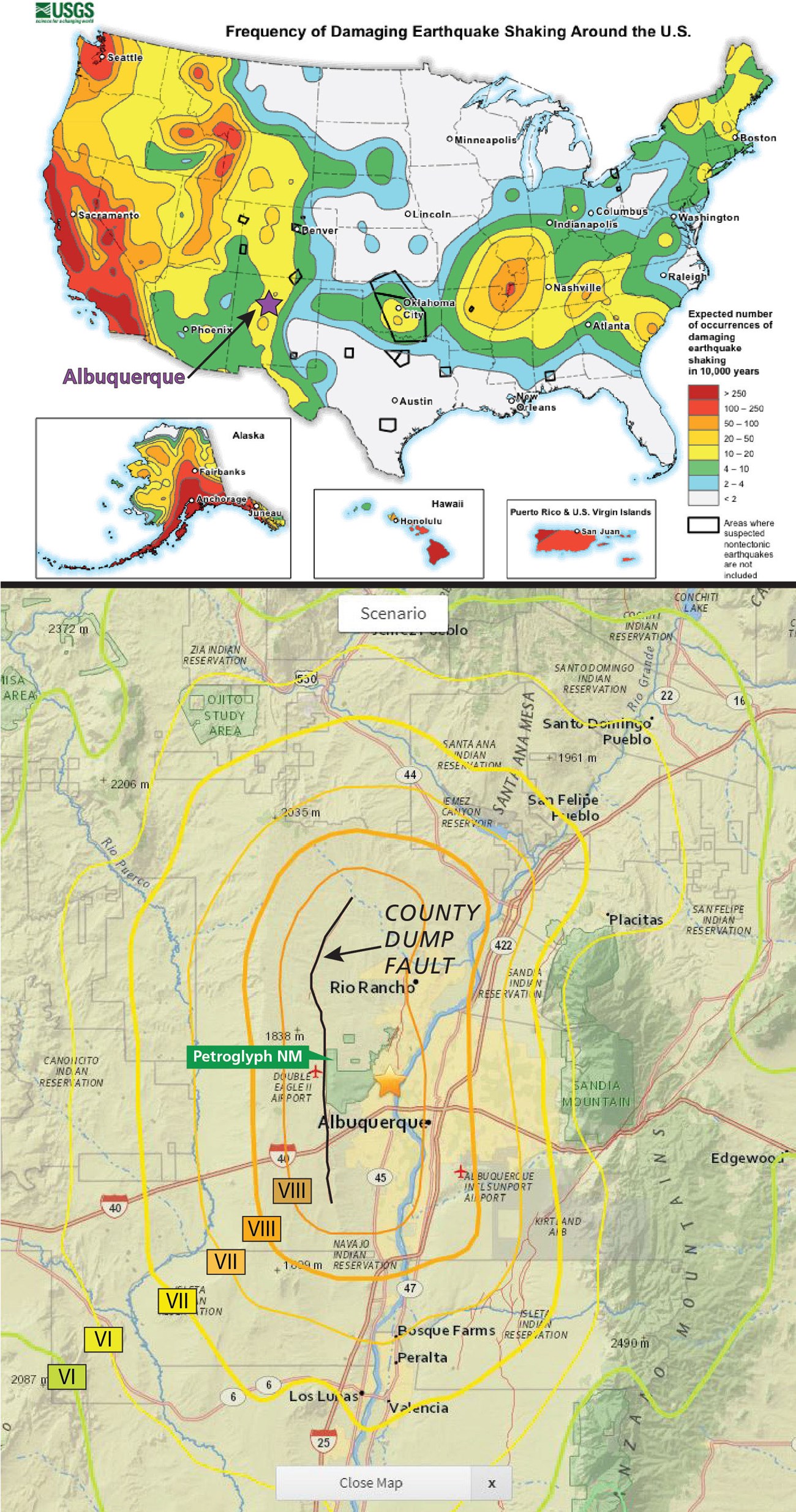
National earthquake probability map and local intensity map. The top map provides national context for the relative probability of earthquakes in the Rio Grande rift area of New Mexico. The yellow area, which surrounds Albuquerque corresponds to an expected 10 to 20 earthquakes with “damaging shaking” (MMI VI) over a 10,000 year period. This corresponds to between “1 in a thousand” and “1 in 500” probability of a damaging earthquake in any year. The bottom map shows projected shaking intensity using the Modified Mercalli Index (MMI) for a magnitude 6.9 earthquake on the County Dump fault. MMI values for Albuquerque and the monument could reach MMI VIII, or “severe” shaking. Earthquakes of those magnitude have occurred in the past along the County Dump and other local faults. National Seismic Hazard Map produced by the US Geological Survey in 2014, available at https://earthquake. usgs.gov/hazards/learn/. Local map is a screenshot of shaking intensity scenario map produced by the US Geological Survey, available at https://earthquake. usgs.gov/scenarios/eventpage/bssc20142038_m6p89_se#executive.
Petroglyph National Monument has a moderate seismic hazard. The USGS 2014 Seismic Hazard Map indicates that the Petroglyph area has a 2% chance that earthquake peak ground acceleration of between 18 and 20 %g (percent of gravity) being exceeded in 50 years. This peak ground acceleration is roughly equivalent to VI to VII on the Modified Mercalli Intensity Scale. The expected number of damaging earthquake shaking in the vicinity of Petroglyph National Monument in 10,000 years is between 10 and 20.
Related Links
Abandoned Mineral Lands
Three Abandoned Mineral Lands (AML) sites have been documented by the National Park Service in Petroglyph National Monument. The sites are abandoned cinder quarries. One of these abandoned quarries requires remediation.
An additional cinder quarry mined a small cinder cone out of existence prior to the establishment of the monument in 1990.
NPS AML sites can be important cultural resources and habitat, but many pose risks to park visitors and wildlife, and degrade water quality, park landscapes, and physical and biological resources. Be safe near AML sites—Stay Out and Stay Alive!
Related Link
- Scoping summaries are records of scoping meetings where NPS staff and local geologists determined the park’s geologic mapping plan and what content should be included in the report.
- Digital geologic maps include files for viewing in GIS software, a guide to using the data, and a document with ancillary map information. Newer products also include data viewable in Google Earth and online map services.
- Reports use the maps to discuss the park’s setting and significance, notable geologic features and processes, geologic resource management issues, and geologic history.
- Posters are a static view of the GIS data in PDF format. Newer posters include aerial imagery or shaded relief and other park information. They are also included with the reports.
- Projects list basic information about the program and all products available for a park.
Source: NPS DataStore Saved Search 3144. To search for additional information, visit the NPS DataStore.
A NPS Soil Resources Inventory project has been completed for Petroglyph National Monument and can be found on the NPS Data Store.
Source: NPS DataStore Saved Search 3095. To search for additional information, visit the NPS DataStore.
GRI Geology Image Gallery
Related Articles
Petroglyph National MonumentNational Park Service Geodiversity Atlas
The servicewide Geodiversity Atlas provides information on geoheritage and geodiversity resources and values within the National Park System. This information supports science-based geoconservation and interpretation in the NPS, as well as STEM education in schools, museums, and field camps. The NPS Geologic Resources Division and many parks work with National and International geoconservation communities to ensure that NPS abiotic resources are managed using the highest standards and best practices available.

